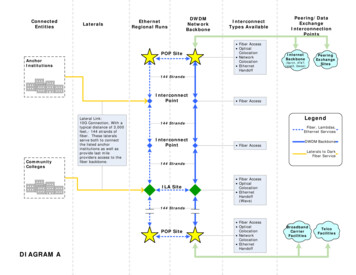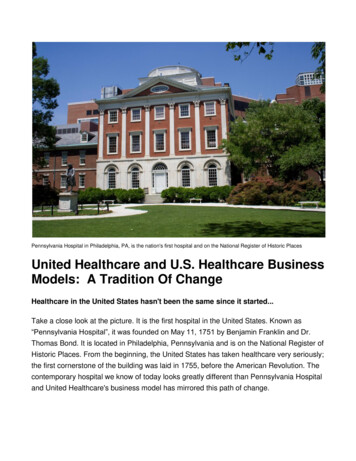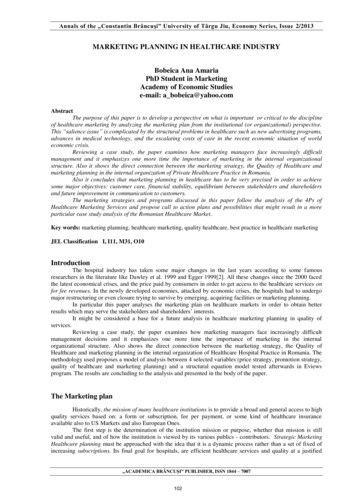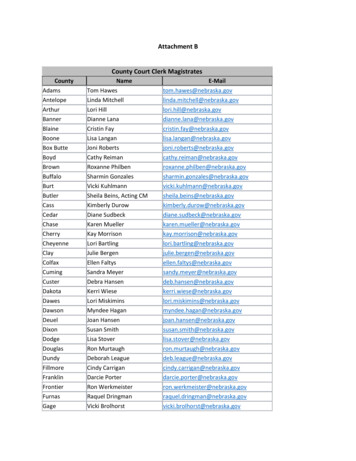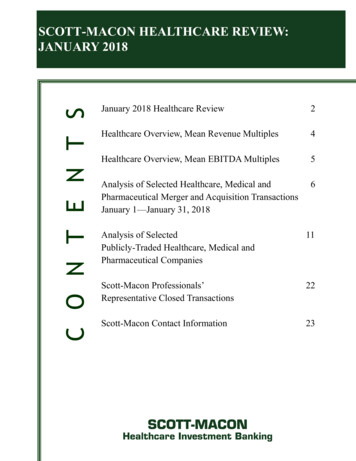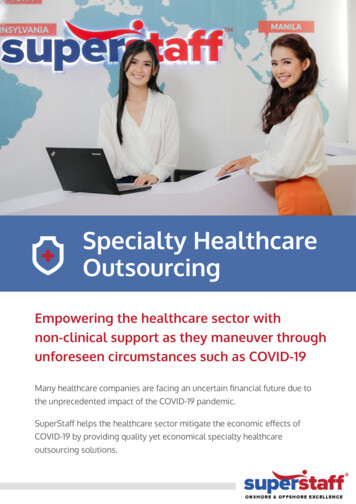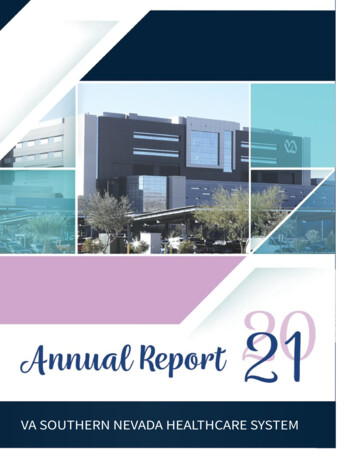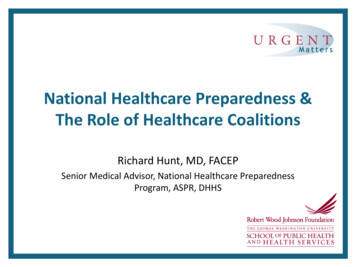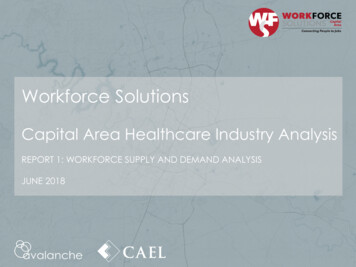
Transcription
www.healthcareil.comPage 1Newsletter November 2016Healthcare.gov will recommendnew plans to left-behind enrolleesIn Our Newsletterby Grant Ferowich Oct 6, 2016AMERICANS WHO BUY HEALTHINSURANCE THROUGH EMPLOYERS TOSEE PREMIUM INCREASESThe Obama administration will launch a strategy to keep consumersenrolled in public exchange plans even if their plans have beendiscontinued due to insurers' exits from the marketplaces.Upon logging in to Healthcare.gov during open enrollment, suchconsumers will see a message that reads: “If your current plan isn’tavailable for 2017, an alternate plan is displayed for you to consider,”according to a Centers for Medicare & Medicaid Services documentobtained by FierceHealthPayer.Between Nov. 1 and Nov. 15, these consumers will get at least seven“touches” or notifications about their plan options.The next phase, between Nov. 16 and Nov. 21, will include three moretouches, detailing the name of an insurer that can offer a comparablehealth plan as consumers’ previous discontinued plan. Consumers willreceive a welcome packet and bill from the insurer, which CMS saysconsumers should keep until they’ve registered for 2017 coverage.There’s no requirement to pay the bill with the recommended insurer, butCMS will encourage consumers to make a final decision by Dec. 15.CUSTOMERS WHOSE POLICIE AREDISCONTINUED WILL BE MATCHED TOALTERNATIVE POLICIESSENIORS: TOP 8 CREDIT CARDS FOREXCELLENT CREDITSEVERAL LARGE INSURERS NOLONGER PAYING BROKERS TO HELPCONSUMRS ENROLL IN ACA PLANSACA PROVISION MAY BE HINDERINGADMINISTRATION’S EFFORTS TOATTRACT MILLENNIALS TOMARKETPLACESEXPERTS SAY THIS IS THE BESTCANNED PUMPKIN FOR YOURTHANKSGIVING PIEIn the final phases, CMS will reach out to consumers who aren’t actively looking for ACA plans up to 20times urging them to renew coverage. Between Dec. 16 and Dec. 31, consumers with discontinuedcoverage will get at least five more reminders.The Obama administration hasn't disclosed how many people will receive the notices, but analystsproject anywhere from several hundred thousand to more than 1 million, the AssociatedPress reported. Given that approximately 11 million people rely on the exchanges for coverage, thecampaign targets less than 10 percent of ACA enrollees.Cynthia Cox, associate director for the program for the study of health reform and private insurance atthe Kaiser Family Foundation, told FierceHealthPayer in an email that “this policy may help boost thenumber of people signed up on the exchange,” since it will keep them from missing enrollment
www.healthcareil.comPage 2deadlines. Still, she noted that rising premiums may lower the incentive for some consumers to buyACA plans.“Regardless of whether it’s the insurer or the government automatically renewing customers, it’s stillimportant for people to actively shop for coverage each year. Premiums and insurer participation arechanging, as are individuals’ circumstances, so the plan that was best for you this year may not be thebest plan for you next year,” Cox wrote.Lastly, Cox noted the effort is comparable to what private insurers regularly do: automatically re-enrollmembers into the same or similar plan when it’s time to pick a health plan, but consumers retain theliberty to switch plans.Still, Elizabeth Carpenter of Avalere Health told the AP that "many consumers are likely to be wary ofinformation from another insurance company," adding that some enrollees choose plans based onbrand recognition while others have a nuanced understanding of different benefit and networkdesigns.
www.healthcareil.comPage 3For most Americans, healthcare costs aren’t skyrocketingBy Beth Pinsker Tue Oct 11, 2016The rising cost of healthcare was a brief topic of conversation at Sunday night's presidentialdebate, with Donald Trump bemoaning the high cost of premiums under Obamacare and HillaryClinton talking about how to fix what we already have.But as Clinton pointed out, the vast majority of Americans get their health insurance through theirworkplace. So they have little to do with the plans on the state exchanges that were createdthrough the Affordable Care Act. But those Americans still have huge concerns about risingcosts.Most of this country's 170 million workers will see cost increases when they get their 2017 openenrollment packets this fall. But this year's costs increases are lower than in previous years,industry analysts say. And employees are bearing less of the burden of those increases, althoughthey are still running ahead of inflation.Benefits consultant Mercer found that cost growth is stable at 4 percent for 2017, while inflationis running under 2 percent. The National Business Group on Health, a non-profit trade group,pegged that number at 5 percent.These numbers are the cost increases after you account for measures that employers take to cutcosts. Otherwise, the costs increases would be even higher. Tops on the lists of strategies: raisingdeductibles or switching carriers, which usually means smaller networks and reduced benefitslike out-of-network coverage.Less of those costs will be passed along to the consumer this year. That means the bottom line –your monthly premium, the annual deductible and coverage for specialty concerns – will beroughly in line with what you paid last year. NGBH said the median deductible for in-networkservices for all plan types is 1,425 for an individual, and 2,900 for a family.Mercer attributes the hold on cost-shifting to employees to a delay in the implementation of theexcise tax provision of the Affordable Care Act from 2018 to 2020. That tax will eventuallyapply to benefit plans exceeding certain parameters. Employers have been cutting benefits overthe past few years.
www.healthcareil.comPage 4Top 8 Credit Cards For Excellent CreditThomas Donaldson,*Editorial Note: This content is not provided or commissioned by the credit card issuer. Any opinions, analyses, reviews orrecommendations expressed in this article are those of the author’s alone, and have not been reviewed, approved or otherwiseendorsed by the credit card issuer. This site may be compensated through the credit card issuer Affiliate Program.Do you have excellent credit? If so, it’s time to upgrade to a better rewards credit card.The banks are fighting harder than ever to win customers with excellent credit. Take advantage of your excellentcredit today by getting a card that earns you more rewards. Our credit card experts have selected the top 8 creditcard deals you can take advantage of right now:BankAmericard Travel Rewards Credit CardWith the BankAmericard Travel Rewards credit card, you'll earn 1.5 points for every dollar you spend, andpoints can be redeemed for nearly any travel purchase in the form of a statement credit. This card comes with a20,000-point sign up bonus when you spend 1,000 in the first 90 days. That can be a 200 statement credittowards travel purchases, and it’s one of the few travel rewards cards with no annual fee. This card also offers noforeign transaction fees, making it perfect for traveling abroad. If you’re a traveler looking for a simple no annualfee card that won’t restrict your travel to certain airlines, giving you the flexibility to travel on any airline, at anytime, with no blackout dates, then this card is for you.Citi Double Cash Card – 18 month BT offerThis is one of the best cash rewards card out there because it gives you cash back twice. You’ll earn 1% backwhen you make a purchase, and another 1% back when you make a payment. You’ll also receive a 0% intro APRon balance transfers for 18 months. This is very helpful in paying off a balance when you transfer it to this cardfrom another credit card. The best part about this card’s cash back? There’s no limit to the amount of cash backyou can earn! This card is perfect for people who don’t want to keep up with rotating categories each quarter.When used responsibly, this card is a cash back machine. With a great rewards rate, 18 months of 0% intro APRon balance transfers, and no annual fee, the Citi Double Cash is a smart choice for just about everyone!
www.healthcareil.comPage 5Capital One Venture Rewards Credit CardAnother top travel card. This card earns you 2 miles for every 1 spent and comes with a 40,000 mile sign upbonus after you spend 3,000 on purchases within the first 3 months – equivalent to 400 in travel. It does havean annual fee of 59, but it’s waived the first year. The card allows you to fly any airline, stay at any hotel,anytime with no blackout dates a real plus for last minute travel plans. It also has zero foreign transaction fees andyour miles don’t expire. All of these benefits make the Capital One Venture Card a great fit for all travelers andeven once-a-year vacations!Chase Slate This is one of the most popular cards for balance transfers. The Chase Slate is the only card that has the uniquecombination of a long 0% intro APR, 0 annual fee, and 0 intro fee on transfers made within 60 days of accountopening. If you are paying interest on any balance, you can transfer it completely for free within the first 60 daysyou have this card. It’s available to those with good credit, so it’s okay if your credit score isn’t quite perfect. Ifyou’re ready to put your credit card debt behind you, the Chase Slate has all the tools and perks you need tomake it happen.Discover it Cashback Match This cash rewards card comes with a unique sign up bonus unlike anything you’ve seen; At the end of your firstyear, Discover will match the cash back you’ve earned. This is the only credit card that will match your cash backat the end of the first year. So if you earned 200 in cash back from purchases in your first year, Discover willmatch it, making your total cash back for the year 400! The Discover it card earns 5% cash back in popularspending categories that change each quarter and 1% on all other purchases. The 5% cash back categories includethings like gas, groceries, dining, and more. On top of the incredible rewards program, this card comes with 0%intro APR on purchases and balance transfers for 12 months. There is even no annual fee, no foreign transactionfees, and no late fee for your first late payment. This card is perfect for cash rewards, financing a big purchase,transferring your high interest debt, and avoiding bank fees to help you save money.
www.healthcareil.comPage 6BankAmericard Cash Rewards Credit Card0% APR for 12 billing cycles, combined with 3% cash back on gas, 2% cash back on grocery stores/wholesaleclubs, and 1% cash back on everything else makes this card a top pick. Did we mention this card comes with noannual fee? In case that wasn’t enough, you’ll also gain access to Bank of America’s award winning online &mobile banking. The reward rates get even better if you have a Bank of America checking or savings account andredeem your cash rewards into your checking or savings account. Finally, when you spend just 500 in the first90 days, about 6 a day, you’ll receive a 100 bonus. With cash back, no annual fee, a long 0% intro APR, and a 100 sign up bonus, and you can see why this card is a top pick of ours!Citi Diamond Preferred CardThis card perfect for people looking to avoid paying interest or who want to finance a large purchase. The CitiDiamond Preferred offers a 21-month 0% introductory APR for purchases and balance transfers – with no annualfee! That means you won’t have to pay any interest all the way into 2018. By transferring your other high interestcredit card balances to this card, you’ll have almost two years to pay off your balances. You’ll also gain access toCiti Private Pass for exclusive presale tickets and a Personal Concierge Service available to assist you 24/7. Witheach purchase, you’ll earn City Easy Deal points with each card purchase redeemable for discounts on onlinemerchandise, travel tickets, gift cards, and more.Chase Freedom Unlimited With this card, there’s no annual fee, and you’ll get 150 bonus cash after spending 500 in the first three months.There’s nothing better than free bonus cash, and on top of that, this card has 0% intro APR on purchases andbalance transfers for 15 months. The ongoing APR is 14.24%-23.24% Variable. For ongoing rewards, the ChaseFreedom Unlimited card earns 1.5% cash back, and as the name implies, there’s no limit to how much you canearn. This card allows you to shop and travel with confidence because it comes with zero liability protection,chip-enabled security, purchase protection, price protection, and auto rental collision damage waiver. See termsand more details on the application page.
www.healthcareil.comPage 7As Insurers Cut Brokers’ Commissions, ConsumersMay Have One Less Tool For EnrollmentBy Julie Appleby November 1, 2016With open enrollment set to begin today, some health insurance brokers are already fieldingquestions about coverage and whether existing plans will still be available next year. For anincreasing number of brokers, there’s also another question: Will they get paid?Some insurers — including Cigna and Aetna — will not pay licensed agents and brokers acommission for helping people enroll in individual health insurance coverage for 2017 in manystates, while others have reduced their commissions. They join UnitedHealthcare, which droppedcommissions on new business this year in many states.That is already prompting some brokers to step back from the exchanges when open enrollmentbegins this week, which could be a hurdle for consumers who normally would seek help frombrokers in navigating the complexities of insurance coverage. (Government-supported navigatorsare still available.)In Nevada, where the largest carrier in the state has cut commissions for new business andanother has dropped payments to 10 a month per customer, broker Vickie Mayville is weighingher options.“It sometimes takes four hours to ensure clients have the right plan,” said Mayville, who runs herown agency in Las Vegas. “I will help my clients and anyone referred to me, but I’m not activelyseeking out new clients.”The changes to these payments come at a time when, for many consumers, selecting a plan maybe even more complex than in the previous three years, as insurers drop out of markets and thosethat remain alter their networks of doctors and hospitals or make other variations to the 2017plans.“I’m trying to find coverage that will include my doctor, which is hard to find,” said ShelbyNathans, 31, who lives in Columbus, Ohio. This year, her plan’s insurer faced financialdifficulties and was closed by the state. As a result, she had to switch just months ago to a newinsurer, which she likes. But now she has learned her primary care doctor isn’t in the plan’snetwork for 2017.Luckily, her father is a broker and he’s going to help her shop around: “If I were just youraverage patient or health insurance customer, I would have no idea what to do,” she said.About 45 percent of consumers in the nation’s largest state marketplace — California — used abroker this year, up from 40 percent when the law went into effect. While the federal governmenthas not released information on brokers’ involvement on a national level, patient advocates saythey’ve been told by officials that a similar percentage occurs across the federal marketplace,which will serve 39 states next year. Even larger percentages among the estimated 6 millionpeople who buy coverage outside of the state and federal marketplaces are likely to use brokers.
www.healthcareil.comPage 8And that, some advocates say, is why problems could be brewing. If brokers cut back their clientlists as a result of the reimbursement changes, that could result in “lower enrollment for theexchanges, which really hurts everyone,” said Marcy Buckner, a vice president at the NationalAssociation of Health Underwriters, the brokers’ lobbying arm.Commissions have long been part of the market for insurance plans sold to individuals andfamilies who don’t get coverage through their jobs. The commissions are built into the premiumsthat insurers charge, which are filed with state regulators. Some pay a percentage of the cost ofthe plan, while others set a flat-dollar rate per application.Brokers say they sort through insurers’ networks of doctors and covered drug lists, helping clientschoose a plan that includes the providers and drugs they require. During the year, they’re alsoavailable to assist if problems with coverage or claims arise.In some states, brokers are allowed to charge consumers a fee for their services, so long as theydisclose it up front. Matthew Byrne, a broker in Dublin, Ohio, charges a 50 consultation fee fornew clients to help walk through the process, whether or not they buy a plan. While still notcommon, Byrne expects that more brokers will do so as commissions decline or are eliminated.To be sure, many consumers sign up or renew online with no additional help.Others get help from call centers as well as navigators or assisters who are paid by the state orfederal marketplaces where consumers shop for coverage. They can show consumers theiroptions and aid in the enrollment process but cannot recommend specific plans.Advocates are optimistic that there will be sufficient help offered by navigators and assisters thisyear — even if they see more clients because brokers move away from the health exchanges.“We feel that navigators and assisters are in a strong place this year to help consumers enroll orrenew their coverage,” said Rachelle Brill, policy analyst with Community Catalyst, a Bostonbased nonprofit advocacy group.Still, brokers are really important in making sure people don’t “slip through the cracks.”Brokers and policy experts say insurers’ decisions come for two main reasons. First, they’reunder pressure to keep premiums from growing too much — and to meet rules in the AffordableCare Act that they spend no more than 20 percent on costs, profits and overhead, the companiesare looking for ways to cut costs anywhere they can.Second, some don’t want much new business. Rules in the law that keep them from rejectingpeople with health conditions have meant higher-than-estimated costs for some insurers, whichhave substantially reduced their participation in state and federal marketplaces, saying they arelosing money on that business sector.“They would rather have less business than more,” until the profit outlook improves, saidconsultant Robert Laszewski, a former insurance executive who advises the health care industry.
www.healthcareil.comPage 9Cigna spokesman Joe Mondy said the company decided to cut commissions entirely for 2017 toreflect “the evolving reality of the individual marketplace.”At Aetna, which has pulled out of 11 states for its products sold on the public exchanges,spokesman Ethan Slavin sent a statement saying the insurer considered “the financial losses” thefirm experienced in the public marketplaces and “took a careful look at our sales andcompensation strategies for off-exchange products” in deciding to cut commissions in 14 statesfor 2017. It continues to sell through the marketplaces in four states.Meanwhile, the changes in reimbursement have prompted concern from some regulators.Nevada’s insurance commissioner in September warned insurers that changes in reimbursementmight run afoul of the law. In Connecticut, regulators, alarmed that insurers had cut commissionsentirely, hired 21 brokers to help out at the state’s health insurance call centers and storefronts.And California reminded the insurers that it requires them to offer commissions on products theysell through its marketplace.
www.healthcareil.comP a g e 10Popular ObamaCare provision hampering push for millennialsBy Sarah Ferris - 11/01/16One of the most popular pieces of ObamaCare could be hurting the administration’s push to attract moreyoung people into the wobbly marketplace, according to several people who helped shape the law.The administration is staging campus enrollment drives and pouring money into Facebook and Instagramads this year in an attempt to boost ObamaCare enrollment among young adults. The sign-up period beginsTuesday.Yet there’s a fundamental flaw in the effort — and it has to do with ObamaCare’s design.Because of the healthcare law, the White House says nearly 3 million young people under the age of 26have been able to stay on their parents’ insurance plans and don’t have to shop for coverage onHealthCare.gov.That’s about double the number of young people between the ages of 18 and 25 who are currentlycovered through the exchanges.“I think that is an argument that has some validity,” John McDonough, a senior adviser to the Senatecommittee that wrote ObamaCare, said in an interview.“If we didn't allow these kids to go on their parents’ plans, many of these kids would have gone to theexchange and would have created a more stable marketplace under the exchange,” said McDonough, whonow teaches at Harvard University's T.H. Chan School of Public Health.Recruiting young people is a central aim of the White House’s final sign-up drive this fall. It’s a particularlycrucial task because insurers are panicking about the number of sick and older people enrolled inObamaCare; some insurers have dropped out of the exchanges altogether.The White House initially hoped adults under the age of 34 would make up 38 percent of the marketplace.Instead, that figure is about 28 percent in 2016, according to federal data.Still, experts say lagging enrollment among young people is the result of many factors, including risingpremiums.It’s also difficult to measure how many of the people under age 26 would have opted for ObamaCare, ratherthan a healthcare plan through their jobs, if they weren’t allowed to stay on their parents’ plans.But experts say at least some of those young people would have signed up for ObamaCare if not for thebenefits extension under the law.Jonathan Gruber, who was a key voice during the drafting of the healthcare law, agreed that more youngpeople would have been drawn to the marketplace without that provision.“If we didn't have the expansion to age 26, probably some healthier folks would have come into theexchanges,” he said in an email.But in the end, he said, it wouldn’t be worth it. Leaving out the provision would have resulted in moreuninsured people overall; people between the ages of 18 and 25 are more likely to be uninsured than anyother age group.
www.healthcareil.comP a g e 11Six years after the provision went into place, the uninsured rate for the under-25 population hasplummeted.One study touted by federal health officials — the Gallup-Healthways Well-Being Index — found a 46.5percent drop in the number of uninsured adults between the ages of 18 and 25 since the law was firstenacted.Just 13.9 percent of young people in that age range are now uninsured as of early 2016, an all-time low,according to the Gallup-Healthways data.But that success has a downside for the Obama administration. Health insurers have been counting onyounger, healthier people to sign up with ObamaCare to help defray costs of the older, sicker populations.Back in 2010, the Congressional Budget Office estimated the influx of young and healthy people into theexchanges would lower premiums by 7 to 10 percent.Instead, the opposite has happened in some markets this year. A lack of young people, among otherfactors, has prompted premiums to rise an average of 22 percent across states in the federalmarketplace.In its final sign-up push, the White House is directly targeting millennials. Health officials are running ads onInstagram, Facebook and YouTube and partnering with companies like Lyft.Several of President Obama’s speeches focused on the healthcare law have been delivered at colleges.His most recent speech took place at Miami Dade College, which boasts the largest undergraduatepopulation in the country.The White House has also launched the Healthy Campus Challenge, encouraging university and studentleaders to host sign-up drives, send mass emails about deadlines and post messages through public socialmedia accounts.But college enrollment campaigns are made tougher by the federal provision that allows young people tokeep their parents’ coverage even after graduation.Joe Antos, a healthcare researcher at the conservative American Enterprise Institute, said theadministration will have a tough job convincing students to switch from their parents’ plans.“If you want to get young healthy people to sign up on the exchanges, then don’t give them other optionsthat are better,” Antos said.“Signing up with your parents is clearly the better option for most younger people,” he said, noting that it’slargely a middle-class benefit. “It’s hard to beat that option for young people because it’s basically no effort,and for most of them, either no or very little money.”The idea of allowing young people to stay on their parents’ plans first began spreading in the states a fewyears before ObamaCare. Before the law passed, about 20 states had already decided to extend thescope of what’s called “dependent health coverage.”Several people involved with ObamaCare at the time — including Gruber and McDonough — said theydidn’t know exactly how the policy became part of the law.
www.healthcareil.comP a g e 12McDonough, who worked with the Senate Health Committee on the law, said the idea likely was a popularway to “provide some benefits and some good will for the law right away.” Unlike the marketplaces, whichdidn’t launch until 2013, the protection for young people went into effect immediately.This small team of data scientists has made an algorithm that is turning a giant 19 billion dollar industry upside-down.“Pretty much everybody on both sides of the aisle when it was raised said that makes sense, that's a goodidea,” he said.Since the law’s passage, the idea has had near-universal support in Congress, even amongThe House GOP’s healthcare plan, released with much fanfare in June, specifically says dependents up toage 26 could stay on their parents’ plan, “helping younger Americans receive health care and stabilizing themarket.”
www.healthcareil.comP a g e 13Experts Say This Is The Best CannedPumpkin For Your Thanksgiving PieIt matters which canned pumpkin you buy.Julie R. Thomson Senior Editor, Taste, The Huffington Post 11/09/2016If you’re planning on baking a pumpkin pie for Thanksgiving this year ― which, you reallyshould be ― then we bet you’re going to pick up a can or two of canned pumpkin. While somefolks might take the challenge and make their own pumpkin puree, most like to go the Ina Gartenroute and stick with canned because it usually tastes better. (The fresh stuff can be too watery ―and sometimes just bland.)But which canned pumpkin is the best buy?If you think they’re all the same, you couldn’t be more wrong. The folks at Cook’s Illustratedtested three popular brands ― Libby’s, One-Pie and Farmer’s Market Organic Pumpkin. Eachcanned pumpkin was tasted plain, baked into a cake, and baked into a pie.The results were strikingly different.COOKS ILLUSTRATEDOne canned pumpkin was pale yellow instead of beautiful orange. One was too fibrous. And theother, well, that one was just right. The reason the same product can taste so different is becausewhile they’re all made with pumpkin, they’re actually produced from different varieties ― or indifferent climates ― which effects not only how fibrous the flesh is, but also how sweet it tastes.So what should you be buying this year? Libby’s, no question. Libby’s won the taste test becauseit had the silkiest consistency and a subtle sweetness. It’s made from Dickinson pumpkins, whichare praised for their natural sweetness and tender flesh. These qualities make for killer pies andfluffy cakes. It’s no wonder that Libby’s makes 85 percent of the world’s canned pumpkins.Head on over to Cook’s Illustrated for more information on how they conducted their taste test ―and how each canned pumpkin fared when baked into pie and cake.
www.healthcareil.comP a g e 14To contact us: go to www.healthcareil.com or Call (800) 739-4700
BankAmericard Travel Rewards Credit Card With the BankAmericard Travel Rewards credit card, you'll earn 1.5 points for every dollar you spend, and points can be redeemed for nearly any travel purchase in the form of a statement credit. This card comes with a 20,000-point sign up bonus when you spend 1,000 in the first 90 days.

